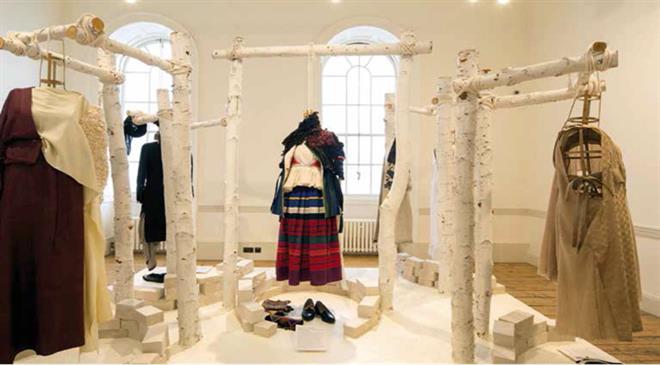Following a vision
Jaspreet Chandok, vice-president and head of fashion at IMG Reliance, is a man with a mission and vision. To put it more accurately-a fashion mission, and he not only wants to give Indian fashion, textiles and crafts a national platform, but a global thrust in international markets too. Chandok, in the two years as the driving force behind Lakmé Fashion Week, ensured that the brand has zoomed up the digital coverage ladder with 1.3 million social media followers with innovative projects that have created industry-changing conversations in design direction, technology, sustainability, craft and inclusivity. Jaspreet Chandok shares his thoughts on fashion in this exclusive Q&A with Meher Castelino.
When he was head of retail for Wills Lifestyle at ITC Ltd, Jaspreet Chandok managed a network of 120 stores across 45 cities; so, his retail expertise matches his fashion acumen. He spearheaded the largest design-retail tie-up in the country with the launch of The Wills Signature Line. Even while in grad college, Chandok, an alumnus of IIM Kozhikode, created his first start-up, which focused on raising money for charitable causes through youth events. Chandok sees fashion beyond Lakmé Fashion Week (LFW) as he works with a diverse set of stakeholders including the ministry of textiles, United Nations and British Council.
How important do you think Indian fashion weeks are for global foreign buyers?
We've seen a significant interest emerge for Indian designers from our interventions globally-whether it was the International Fashion Showcase win at London Fashion Week, or from our discussions with global stakeholders who are engaging with the property more frequently. We are still a largely local industry and Indian fashion weeks haven't broken through as an overall industry and are yet to be a regular stop with all global buyers. But the point really is that there is such a large consumption market within the country that has not yet been tapped either. Maybe greater efforts to align design ranges to market realities will lead to a larger sales increase.

What are India's strengths and weaknesses as far as Indian fashion and designers are concerned?
I'd focus on the strengths as I've mentioned.
Have several fashion weeks in India diluted the business and turned it into a moneymaking racket and a tamasha? Publications, small suburbs and remote towns are organising fashion weeks which are more like exhibitions. Has the term 'fashion week' lost its seriousness?
If some entrepreneurs and businesses feel that they can leverage the fashion industry and create a viable model, then more power to them. Most of these events are ancillary and aid local designers. We don't really feel our property will get diluted whether there are 10 or 100 other fashion weeks, weekends or events.
Do you feel the current season format of LFW is better than the six-months-ahead format, which is globally accepted? Do you feel that the schedule of LFW twice a year matches with the calendar for international buyers?
If you see, a lot of global fashion weeks are struggling with their formats with many designers showcasing in-season now. With a significant change in communication and digital media, design cycles will crunch and we feel our in-season format (especially after moving to early February for spring/summer) allows both designers to create ranges for buyers and gives them the flexibility to amplify their collections, which will soon be available in their own stores as well.
Do you think Indian designers know how to market and publicise their work?
I think it is a work in progress. Some designers are very good at it; others are still learning the ropes. Some have mastered social media; others don't understand it at all.
Some so called 'Weeks' are for two or three days. Your views on what it is doing to the fashion industry.
I think the only fashion weeks that matter are done by the Fashion Design Council of India and IMG Reliance. The others are peripheral to any major conversation on the growth of Indian fashion.
You have been in charge of IMG Reliance organising LFW since Winter/ Festive 2016. What changes have you brought in the four seasons that you have organised?
I have been fortunate to have the support of an incredibly efficient team who put forth path breaking ideas season after season. The mandate is to break new ground, innovate, push the boundaries and create narratives that are relevant to a large set of stakeholders. We have converted the event from an "exclusive" to an "inclusive" property.
Many senior Indian designers can't write two lines about their collection, while Western designers have complete press kits ready. Will IMG Reliance help them to improve their communication skills and PR?
We usually hire senior consultants across various actions and we are happy to have Meher Castelino help out our young and senior designers if they require any assistance for LFW communication. Beyond that, we are currently looking at skill enhancement for young designers, not established ones.
Many Indian designers depend on Bollywood impact more than on their creativity. Please comment.
Fashion also has to make business sense. Each designer looks at various facets that add value to their brand-whether it is showcasing at the right fashion week, using influencers and celebs, working hard on their social media. We do not get into how designers choose to market their brands.
What is your vision for fashion in India?
To have multiple large designer houses as leading retailers across the world.
The dates for LFW have been moved from March to February and from September to August. Has this helped in the business opportunities both for the local and the global markets?
Yes, this is to aid the B2B side of the "in-season" format providing enough time for designer collections in stores.
LFW has now started promoting regional textiles and designers, what happens to them after LFW is over? Does IMG Reliance follow up on their progress?
We provide designers the opportunity to constantly return to the platform, either to showcase their designs on the ramp or to put up stalls that allow them to meet and interact with consumers and buyers on-ground. Some of our projects are also longer term and have a business end.
An example of LFW and IMG Reliance going beyond the show would be the Usha Silai Project. Through the Usha Silai showcase, Usha International in association with IMG Reliance launched the Usha Silai label, which will soon be available at retail outlets starting with the launch at Ogaan.
In spite of LFW being one of the most followed fashion weeks in the world, why is it that no Indian fashion designer can compete with the western ones on their turf?
I don't see a correlation in the question; so, will answer the second part. Designers like Rahul Mishra (will be presenting at Paris Fashion Week), Suket Dhir and Ruchika Sachdeva have won the International Woolmark prize. Our curated set of young designers won the International Fashion Showcase at London Fashion Week. Designers such as Manish Arora and Bibhu Mohapatra have been showcasing internationally for years. So, I'd say we are definitely competitive. Maybe more can break through if given the opportunity. However, designers need to have significant capital to be able to compete internationally as well from a business perspective.
What is LFW doing to attract new buyers?
More engagements with designer stores beyond fashion week; focus on international buyers especially from the Middle East and a much larger venue supporting a better showroom space (at least for the February edition).
IMG Reliance took designers for London Fashion Week and had an installation for which they won an award. What is the follow-up on that?
After we won the best country award for the exhibit we (IMG Reliance) curated along with five young designers, we once again showcased at London Fashion Week taking three of these designers to showcase their collections in the buyer area called the "LFW Showroom". Now it's for the designers to leverage the access we have created to grow their business.
Fashion weeks in India remain a glam event for socialites and the blitz-glitz brigade. A case in point-how many B2B editors do you call for your shows, leave alone first row seating. When will they emerge as serious trade events for the industry? What steps are being taken to ensure that industry takes it as a serious trade event?
Fashion weeks reach out to various sets of stakeholders. We don't want to be too serious and boring and present ourselves as a joyous event. We see ourselves as both a trade and an amplification event; so, it depends on what the designer wants out of the event. Also, we have taken more efforts to reach out to a larger audience than any fashion event-whether it is consumers, national media, inclusion of artisans and retailers. We do a lot of serious work with our curations and focus on sustainable fashion, and hence we have a complete new set of stakeholders like the United Nations and British Council coming in.
What are the flaws in the Indian fashion business that need immediate rectification?
Greater alignment of product to consumer still remains the biggest flaw, leading to the designer industry not being able to tip over into large revenue businesses.
Designers need to go corporate to really make it big. Not quite happening in India. Why? And what is the solution?
All designer brands in India are still first generation, due to which designers do not want to let go of equity nor do they want someone else to have a say in their business and design. There is certainly interest from partners to engage, however the designers need to be more open minded and flexible on the possibilities.
How has your experience with Wills Lifestyle helped in guiding LFW?
Just a better understanding on each facet of a fashion event. I started as a bouncer for the VIP Lounge as a trainee. We've been able to look at the event from a partner's perspective, and hence have seen significant growth in revenues as well.
What is IMG Reliance's role in promoting arts/crafts in India besides organising LFW?
We've been working closely with various stakeholders beyond fashion to come into the fold and work with us in building the craft sector. Today, organisations such as the United Nations in India and British Council interface with the craft industry through us in developmental projects. We've now started looking at corporate intervention as well with Raymond, Usha for development work, which we now see as a major way to drive the sector in the future.
Why is there no Indian high street label that can create a buzz like Zara, Gap, and H&M can?
Fabindia is a ₹1,000 crore brand. AND as well as Global Desi lead in sales in most competitive environments. Most of the Madura Garments brands are market leaders. So, Indian brands do hold up quite strongly against international competition in the high street space.
You have watched and been involved in the Indian fashion scene for several years now. Do you think the retail business is at times to blame for the fashion business being where it is, since designers have to still give on consignment basis?
I've seen most large format multi-brand businesses over a period of time move from outright to consignment, whether it was large format retailers such as Lifestyle and Shoppers Stop or more recently all the e-commerce platforms. Eventually, the market reality is that once demand outstrips supply, the retailer or "supplier" will hold the upper hand. Designers will have to create differentiation and consumer pull to genuinely be able to ensure buyers come searching for their products to reverse the trend.


